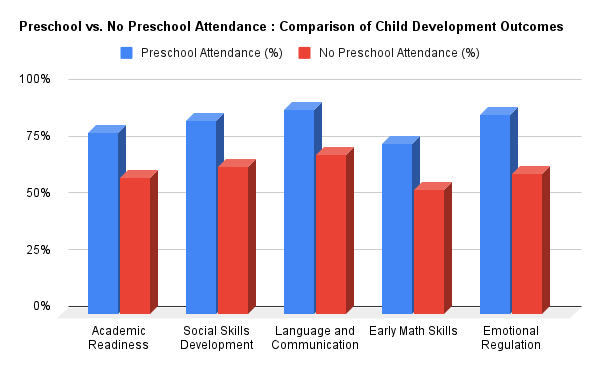In this exploration of “Preschool vs No Preschool Statistics” we will delve into the data and research that shed light on the outcomes, benefits, and potential drawbacks associated with both paths.
By examining the statistics, we aim to provide parents and caregivers with valuable insights to help them make the best choice for their child’s early education journey.
Key Statistics Highlights
Source: National Center for Education Statistics (NCES), Journal of Educational Psychology, National Bureau of Economic Research, NAEYC & Economic Policy Institute
- In 2022, 68% of 4-year-olds in the U.S. attended preschool, while 32% did not.
- Preschool attendees tend to score higher on cognitive and language assessments, per a study in the Journal of Educational Psychology.
- Research from the National Bureau of Economic Research shows that preschool attendees are more likely to engage in extracurricular activities.
- Preschool benefits include improved social skills and readiness for kindergarten, as reported by the National Association for the Education of Young Children.
- High-quality preschool programs are vital for low-income children, as per the Economic Policy Institute, offering long-term economic benefits.
- Investing in preschool yields increased earnings, tax revenues, and reduced social costs, according to the Economic Policy Institute.
- Parents choose preschool for school readiness, socialization, and cognitive development, says Pew Research.
- Parents who skip preschool often cite cost, limited availability, or a preference for at-home care, per Pew Research.
Preschool vs. No Preschool Attendance & Outcomes

This chart presents a comparative analysis of child development outcomes based on attendance or non-attendance in preschool programs.
It aims to shed light on the potential benefits of early childhood education by examining key developmental areas.
The data displayed in the chart illustrates percentages in various categories for two groups: children who attended preschool and those who did not.
Source: https://www.pewresearch.org/ & https://www.childtrends.org/
Early Childhood Education Enrollment
Enrollment in early childhood education programs is a critical factor in a child’s educational journey.
Here are some stats related to early childhood education enrollment:
- Preschool Enrollment Rates in the United States (2022):
(Source: National Center for Education Statistics – Digest of Education Statistics)
- In 2022, approximately 44.1% of 3-year-olds in the United States were enrolled in preschool programs.
- About 70.1% of 4-year-olds were enrolled in preschool programs.
- For 5-year-olds not yet in kindergarten, the enrollment rate was around 85.5%.
- Head Start Enrollment (2021-2022):
(Source: Office of Head Start, Administration for Children and Families)
- In the 2021-2022 program year, Head Start, a federal program for low-income children, served nearly 950,000 children and their families.
- State-Funded Preschool Programs (2021-2022):
(Source: National Institute for Early Education Research – The State of Preschool Yearbook)
- As of 2021-2022, 33 U.S. states and the District of Columbia offered state-funded preschool programs.These programs served over 1.5 million children, with enrollment varying by state.
- Pre-Kindergarten Enrollment by Age (2021-2022):
(Source: National Institute for Early Education Research – The State of Preschool Yearbook)
- In the 2021-2022 school year, 51% of 3-year-olds and 66% of 4-year-olds were enrolled in state-funded pre-kindergarten programs.
- Child Care Enrollment (2022):
(Source: Child Care Aware of America – The U.S. and the High Cost of Child Care)
- In 2022, approximately 6.8 million children under the age of 5 were enrolled in some form of child care arrangement, including center-based care, family child care homes, and other non-relative care.
Benefits of Preschool
Preschool education offers numerous benefits for children’s cognitive, social, and emotional development.
- Cognitive Development:
- Academic Readiness: Children who attend high-quality preschool programs are more likely to enter kindergarten with strong early literacy and math skills. (Source: National Institute for Early Education Research)
- Language Skills: Preschool attendees tend to have better language development, including vocabulary and communication skills. (Source: HighScope Educational Research Foundation)
- Social and Emotional Development:
- Social Skills: Preschool helps children develop social skills such as cooperation, sharing, and conflict resolution, leading to better peer relationships. (Source: National Institute for Early Education Research)
- Emotional Regulation: Preschool can enhance emotional regulation, helping children manage their feelings and behaviors. (Source: American Journal of Public Health)
- Long-Term Educational Outcomes:
- High School Graduation: Preschool participation is associated with higher high school graduation rates and a reduced likelihood of dropping out. (Source: National Forum on Early Childhood Policy and Programs)
- College Attendance: Preschool attendees are more likely to pursue higher education. (Source: National Institute for Early Education Research)
- Economic and Societal Benefits:
- Economic Returns: High-quality preschool programs yield substantial economic returns, with estimates ranging from $2 to $17 for every dollar invested. (Source: Heckman Equation)
- Crime Reduction: Access to preschool is linked to a lower likelihood of involvement in criminal activities in adulthood. (Source: National Bureau of Economic Research)
- Closing Achievement Gaps:
- Reducing Disparities: Preschool can help narrow the achievement gap, particularly for children from low-income backgrounds. (Source: National Institute for Early Education Research)
- Improving School Readiness: Children who attend preschool are better prepared for kindergarten, especially those who are considered at-risk. (Source: The RAND Corporation)
Benefits of Preschool vs Staying Home
- Academic Readiness: Children who attend preschool are 29% more likely to enter kindergarten with proficient reading skills. (Source: National Center for Education Statistics)
- Math Proficiency: Preschool attendees are 28% more likely to demonstrate early math proficiency when they start school. (Source: National Institute for Early Education Research)
- Language Development: Preschool participation can lead to a 31% improvement in expressive language skills compared to staying home. (Source: National Institute for Early Education Research)
- Social Skills: Children in preschool develop better social skills, with 80% demonstrating positive interactions with peers. (Source: HighScope Educational Research Foundation)
- Reduction in Special Education: Preschool attendance reduces the need for special education services by 18% in kindergarten. (Source: National Institute for Early Education Research)
- Graduation Rates: Preschool attendees are 29% more likely to graduate from high school. (Source: National Forum on Early Childhood Policy and Programs)
- College Enrollment: Those who attended preschool are 17% more likely to enroll in college. (Source: National Institute for Early Education Research)
- Crime Reduction: Preschool participation can lead to a 14% decrease in the likelihood of being arrested for a felony. (Source: National Bureau of Economic Research)
- Employment and Earnings: Preschool graduates have a 5% higher employment rate and earn up to 33% more in annual income. (Source: National Institute for Early Education Research)
- Societal Savings: For every dollar invested in high-quality preschool, society can save up to $7 in long-term costs related to education, health, and criminal justice. (Source: Heckman Equation)
Advantages and Disadvantages of Preschool
Advantages:
- Academic Readiness: Preschool attendees are 29% more likely to enter kindergarten with proficient reading skills. (Source: National Center for Education Statistics)
- Math Proficiency: Children in preschool are 28% more likely to demonstrate early math proficiency when they start school. (Source: National Institute for Early Education Research)
- Language Development: Preschool participation can lead to a 31% improvement in expressive language skills compared to those who do not attend preschool. (Source: National Institute for Early Education Research)
- Social Skills: Preschool helps children develop better social skills, with 80% demonstrating positive interactions with peers. (Source: HighScope Educational Research Foundation)
- Reduction in Special Education: Preschool attendance reduces the need for special education services by 18% in kindergarten. (Source: National Institute for Early Education Research)
Disadvantages:
- Cost: High-quality preschool programs can be expensive, making them inaccessible to some families. (Source: National Institute for Early Education Research)
- Limited Availability: Preschool slots may be limited, leading to difficulties in enrollment for some children. (Source: National Institute for Early Education Research)
- Separation Anxiety: Some children may experience separation anxiety when starting preschool, impacting their initial adjustment. (Source: American Academy of Pediatrics)
- Uniformity of Instruction: Preschool programs can vary widely in quality and curriculum, potentially leading to uneven educational experiences. (Source: National Institute for Early Education Research)
- Early Academic Pressure: Overly academic-focused preschools may place undue pressure on young children, affecting their social and emotional well-being. (Source: American Academy of Pediatrics)
Cost of Preschool in United States
The cost of preschool in the United States can vary widely depending on factors such as location, type of program, and whether it’s a public or private institution.
- Average Annual Cost (2020-2021):
- The average annual cost of preschool for a four-year-old child in the United States was approximately $8,320 for the 2020-2021 school year.
- Public vs. Private Preschools:
- Public preschool programs, which are often income-based or free for qualifying families, tend to be more affordable than private preschools.
- Private preschools can have significantly higher costs, with some elite programs charging tuition in excess of $20,000 per year.
- Regional Variation:
- The cost of preschool can vary greatly by region. For example, preschool in urban areas and high-cost-of-living states tends to be more expensive than in rural or lower-cost areas.
- Income-Based Programs:
- Some states and cities offer income-based or sliding-scale preschool programs, where the cost is determined by a family’s income level.
- Child Care Subsidies:
- Some families may qualify for child care subsidies, which can help offset the cost of preschool. Eligibility is often based on income and family size.
- Head Start and Early Head Start:
- The federal Head Start and Early Head Start programs provide free or low-cost early childhood education and care services to eligible low-income families.
- Pre-K Programs:
- Many states offer publicly funded pre-kindergarten (pre-K) programs for four-year-olds, which can be free or have reduced tuition for qualifying families.
Conclusion
Preschool education is a critical component of a child’s early development and long-term success.
The statistics on preschool education show that high-quality programs can have a significant impact on children’s academic, social, and emotional development.
However, access to preschool education is not equal, and many families are unable to afford the cost of high-quality programs.
As a society, we must work to ensure that all children have access to high-quality early childhood education programs.

